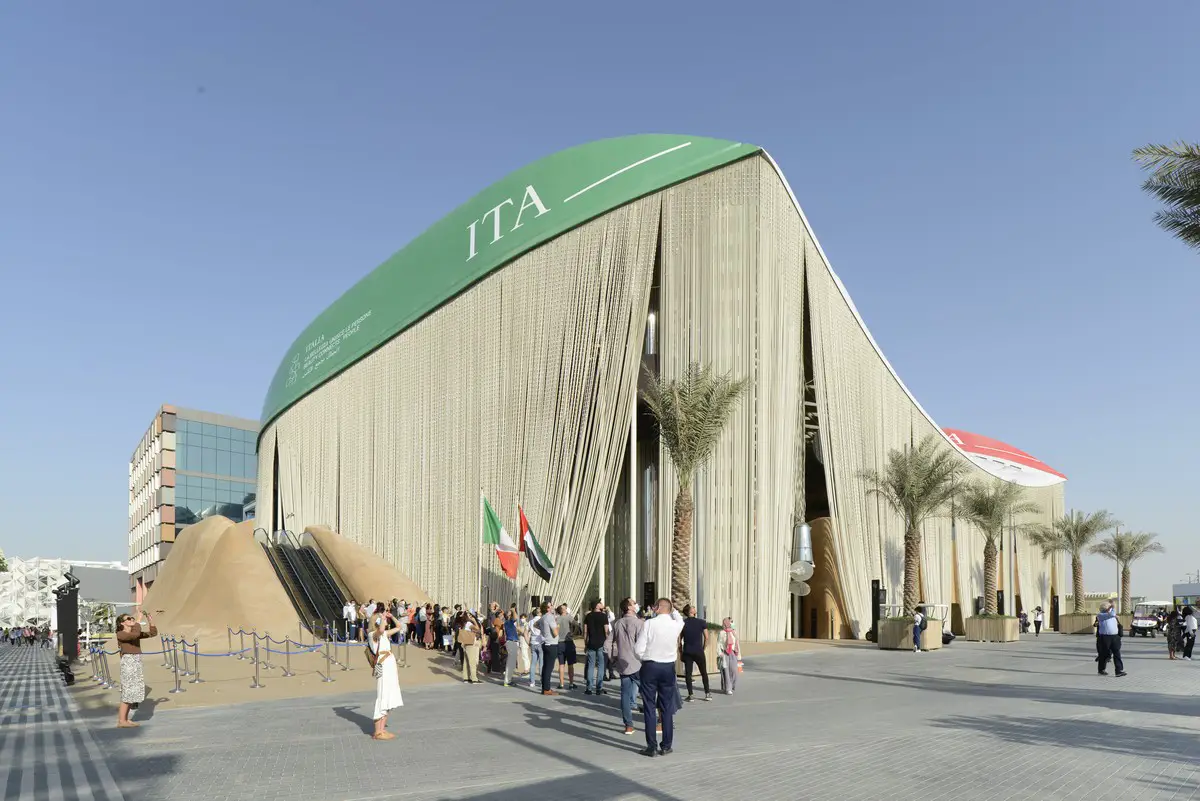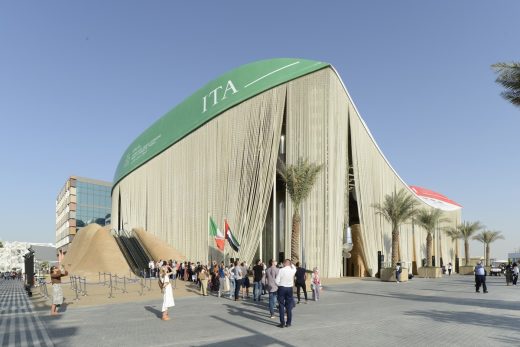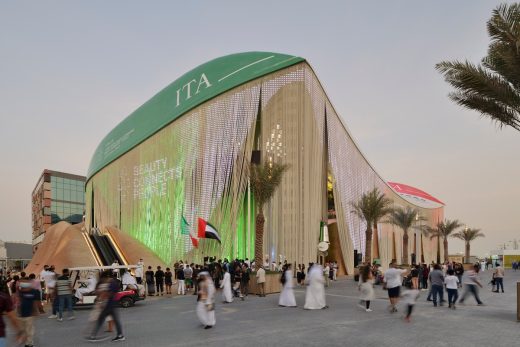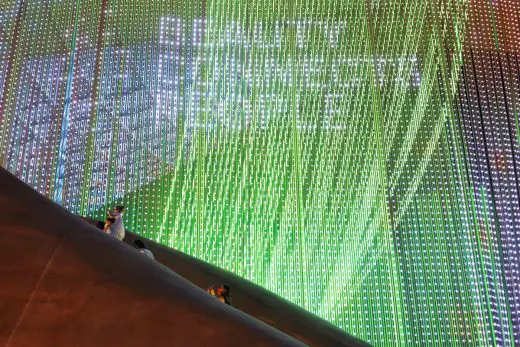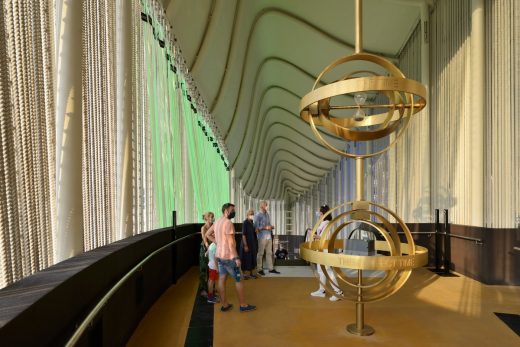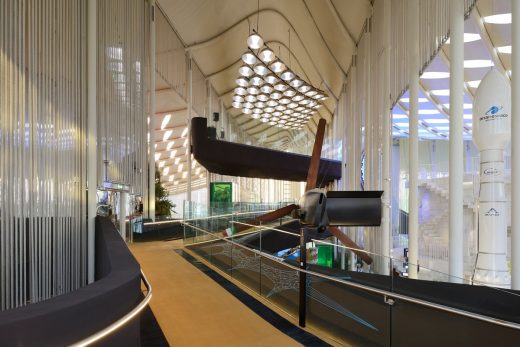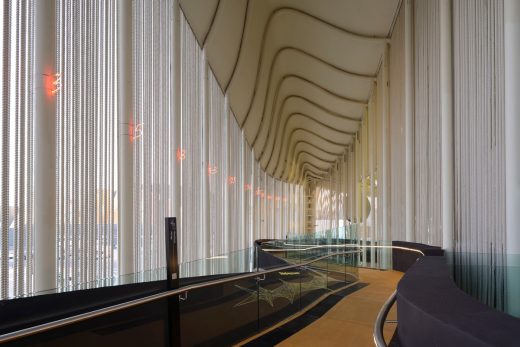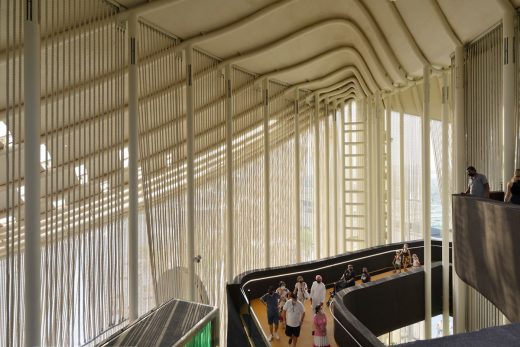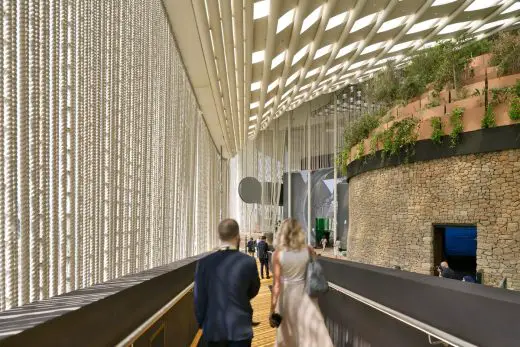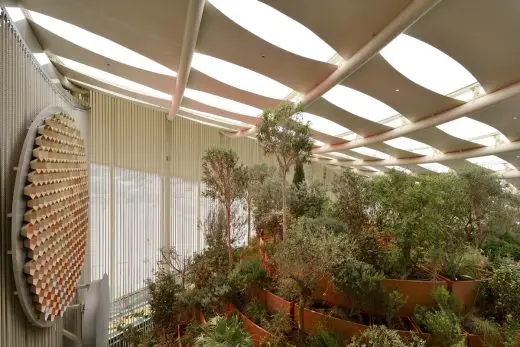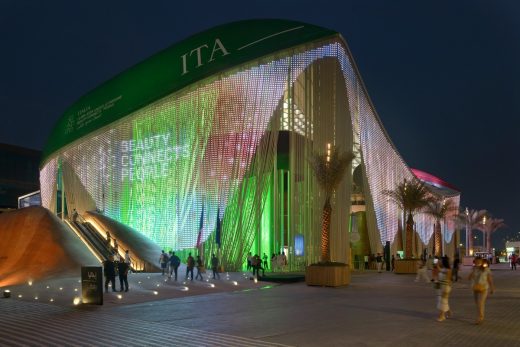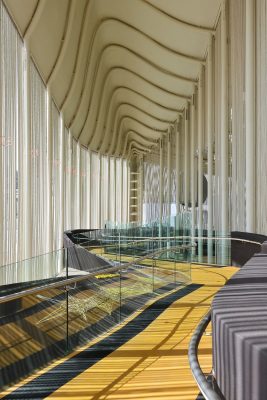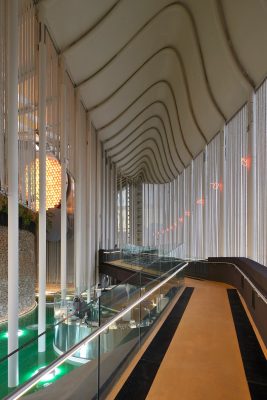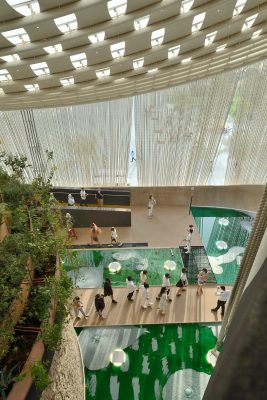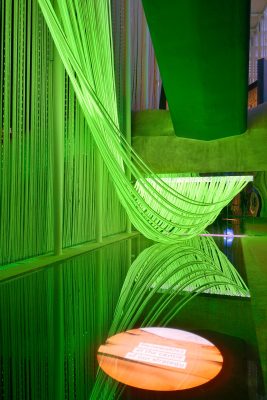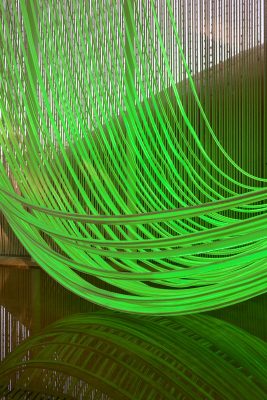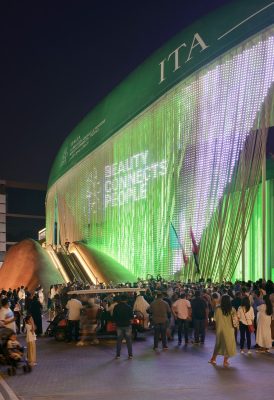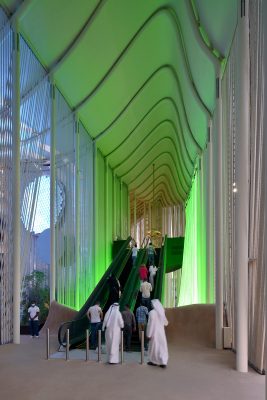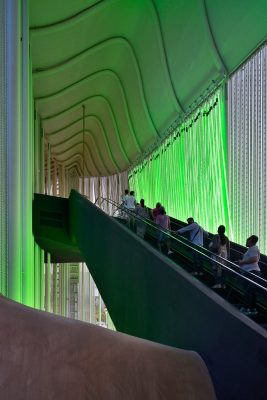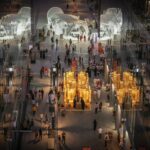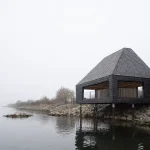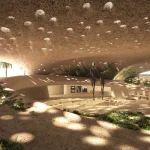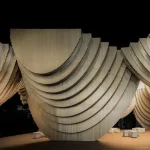Expo 2020 Dubai Italian Pavilion Building, Architect, UAE Design Project Photos
Expo 2020 Dubai Italian Pavilion Design
5 October 2021
Design: CRA-Carlo Ratti Associati and Italo Rota Building Office
Moving Architecture: Unveiling the Italian Pavilion Building at Expo Dubai 2020
Italy’s Pavilion at Expo Dubai 2020 opens to the public as an experiment into reconfigurable architecture and circularity. It features three boat hulls as the structure’s roof; a multimedia facade made with two million recycled plastic bottles; and a natural climate mitigation system that substitutes for air conditioning. The pavilion was designed by CRA-Carlo Ratti Associati and Italo Rota Building Office, with Matteo Gatto and F&M Ingegneria.
Photos by Michele Nastasi
Italian Pavilion at EXPO 2020 Dubai
Dubai, UAE, OCTOBER, 2021 – The Italian Pavilion building at Expo Dubai 2020, designed by CRA-Carlo Ratti Associati and Italo Rota Building Office, with Matteo Gatto and F&M Ingegneria, was officially unveiled on October 1st, 2021, as part of the first World Expo ever held in the Arab world. The project puts forward an all-encompassing vision for reconfigurable architecture and circular design involving some of Italy’s most innovative companies.
The pavilion features a multimedia façade made with two million recycled plastic bottles, new types of building materials – from algae and coffee grounds to orange peels and sand – and an advanced system for climate mitigation that constitutes an alternative to air conditioning. Reusing is also fundamental to how the structure was conceived. The pavilion utilizes three real-sized boat hulls, which could potentially set sail after the event, to create and shape the roof of the building. The Italian Pavilion extends over a surface of 3.500 square meters (38.000 square feet) and will be open until March 31st, 2022.
The Italian Pavilion envisions an architecture which challenges how buildings are usually developed for temporary events such as a World Expo, in which a lot of newly-built structures end up as landfill after just a few months. Contrary to that approach, the Italian Pavilion was conceived as an architecture that is able to transform itself through time, in a sustainable fashion. Three hulls, arrived in Dubai, become the roof of the pavilion, and after Expo, they could set sail to new destinations. The boat hulls also refer to the historical connections between the Italian and Arabian Peninsulas, thus hinting at the themes of both Italy’s participation in the Expo (“Beauty Connects People”) and Expo Dubai 2020 as a whole (“Connecting minds, creating the future”).
The three boat hulls that form the pavilion’s roof vary in length from 40 to 50 meters. They were produced with the contribution of Fincantieri, the largest shipbuilder group in Europe. The hulls are supported by more than 150 slender vertical steel pillars, each 27 meters high. In turn, they support a wave-shaped roof membrane made of ETFE pillows and a layer of perforated thin metal sheets that filter the sunlight. Seen from above, the hulls are coated in an innovative paint developed by paints and coatings company Gruppo Boero. They are the three colors of the Italian flag – green, white, and red – and form what might be the biggest ‘tricolor’ in Italy’s history (2100 square meters – 22.600 square feet).
The pavilion has no conventional walls. Instead, a curtain facade made of nautical rope, which also incorporates LEDs that can be lit to transform the facade into a multimedia surface, delineates the exhibition space. The nautical ropes are produced in recycled plastic, using the equivalent of roughly two million bottles, and form an intricate vertical meshwork that stretches almost 70 kilometers (43,45 miles) in length. At the close of the Expo, they will be reused again, in accordance with the logic of the circular economy. The use of the nautical ropes and a localized cooling system integrated with misting allow for extensive shading, natural ventilation, and better thermal comfort. The project strives to showcase more sustainable ways to cool our buildings and cities in the future.
Visitors enter the Italian Pavilion’s interior path via an escalator that takes them to a skywalk suspended 11 meters above ground level, right below the first hull’s nave. From this panoramic point, they can overlook the entire pavilion from a walkway that floats above the exhibition spaces and installations. Among the main spatial features are the Belvedere, a round structure topped by a dome, covered by wild herbs of the Mediterranean maquis, which evokes Renaissance gardens. Here, spirulina microalgae, cultivated by renewable energy company TOLO Green, enables the ecological treatment of air through the biofixation of the carbon dioxide emitted by visitors.
The path also includes an Innovation Space dedicated to technological research, the Second Sun and Second Moon digital installations by Enel X which create a crescendo of light effects closely linked to the visitors’ emotions in real-time, and the Theatre of Memory with a 3D-printed copy of Michelangelo’s David developed by the Museum of the Galleria dell’Accademia of Florence and the Ministry of Culture in partnership with the Department of Civil and Environmental Engineering at the University of Florence. The ground floor of the pavilion features the “Solar Coffee Garden”, a cafe designed by CRA and Italo Rota for leading coffee company Lavazza.
CRA and Italo Rota also designed an installation for global energy company Eni, titled “Braiding the Future”, which focuses on biofixation of carbon dioxide. It recreates a microalgae cultivation using a spectacular cascade of 20-meter-high technological liana vines. Within each of the luminescent lianas flow the microalgae: the see-through circuit becomes a spectacular interpretation of the production technology of these unicellular organisms, which produce high-value compounds through a natural photosynthesis process.
The technology of intensified biofixation of carbon dioxide that inspired the installation was developed in Italy by Eni, Politecnico di Torino, and start-up Photo B-Otic. It allows the intensive cultivation of microalgae through photobioreactors, lit through LED technology optimized on specific wavelengths. Located at the entrance of the pavilion and suspended at full height over a body of water, the installation is a clear reference to Eni’s concrete commitment towards a sustainable future, including possible fixation and enhancement of carbon dioxide. It represents the next chapter in the company’s design collaboration with CRA and Italo Rota, which is dedicated to exploring new materials and solutions for the built environment.
The rest of the Italian Pavilion also includes materials that were chosen in line with the circular approach, developed in collaboration with Mapei, which manufactures chemical products for the building industry. Coffee and orange peels left to dry and reduced to powder, are used to coat the suspended pathways and walkways. The pavilion itself rests on a dune five meters above ground level, made out of locally sourced sand. Moreover, the path inside the Italian Pavilion is enriched by a series of green elements from more than 160 different species that live inside the building. Developed in collaboration with Italy’s National Research Council (CNR) and botanist Flavio Pollano, this natural landscape pays tribute to the biodiversity and ecological beauty of the Italian and Mediterranean territories. Particular attention is given to the role that plants play in stopping desertification.
Hailed from the start as one of the most recognizable designs at Expo Dubai 2020, the Italian Pavilion has won the prize for the Best Entrepreneurial Project of the Year at the prestigious Construction Innovation Awards that are given every year in the country hosting the Exposition. The pavilion will be open for six months, with hundreds of arts and business events scheduled for the space during this time.
QUOTES FROM THE DESIGNERS
“Our design for the Italian Pavilion deals with what I believe is architecture’s most important challenge today: advancing the double convergence between the natural and the artificial. It anticipates issues and suggests strategies that will be increasingly crucial for the future of our cities as we address the consequences of the current climate crisis,” says Carlo Ratti, founding partner of CRA practice and director of the MIT Senseable City Lab at the Massachusetts Institute of Technology (MIT). “The pavilion keeps mutating into different forms. It speaks about reconfigurability both in the long-term, because of its circularity, and in the short term, thanks to its use of digital technologies.”
“The Italian Pavilion has large dimensions and a very sophisticated structure, but more than an architecture in the canonical sense it is a large experimental installation focused on the increasingly blurred boundaries between the natural and the artificial. Its construction is equally inspired by natural biotypes and the most advanced technologies that come from space research,” says Italo Rota, founder of Italo Rota Building Office:
“On the one hand, the building looks at the organization of tropical forests, where light filters through a high canopy and life is organized accordingly. On the other hand, a crucial theme is the production of neo-materia: new construction materials that have an organic and biological origin, whose technological production is not to be mistaken with recycling. Since the pavilion was conceived in a circular way, one can think of this neo-materia as materials that one can potentially be reused anywhere, in different forms and with different purposes. The Italian Pavilion represents almost a sort of ‘architectural banking’: a catalog from which to choose the elements of future architecture.”
“After the design of the Expo Milan site in 2015, it was very interesting for me to participate in the design of a national pavilion for Expo Dubai,” says architect Matteo Gatto. “Representing Italy is never easy, but I believe that the theme of travel and the technology that we developed to execute the concept, and then for the project itself, have managed to well represent the complexity of our country, which is rooted in its history and projected towards the future.”
“Supporting a roof made of three overturned hulls was a real structural challenge. After a careful analysis of the main goals of the architectural project, F&M Ingegneria took care of the structural and plant design, proposing a functional integration between the two disciplines. This solution allowed us to optimize costs and construction work, ensuring the comfort of the pavilion without affecting the overall aesthetics.
The management of engineering work, entrusted to F&M, was particularly demanding in liaising with local companies and workers. But that allowed us to achieve the set goal, ensuring compliance with delivery times”, says Sandro Favero, founder of F&M Ingegneria. “A cross-disciplinary coordination of the project between F&M and the design team allowed for effective and punctual work, along with coordination with the operators on site during the execution phase. The BIM model was implemented in high efficiency from design to construction, allowing us to oversee the process.
The large spaces available on the first deck, called “the great dune”, with large facades without any pillars and the architectural structure entirely exposed, are the result of sophisticated structural analysis conducted by our specialist engineers. The complexity of the construction site that required careful planning in each phase, as well as the creation of highly complex geometric artifacts, have been a challenge for us, which we overcame with great success,” comments Federico Zaggia, Partner and Project Director at F&M Ingegneria.
DESIGN CREDITS
1) Italian Pavilion at Expo Dubai 2020
Dubai, UAE
1 October 2021-31 March 2022
Architecture design:
CRA-Carlo Ratti Associati and Italo Rota Building Office, with Matteo Gatto and F&M Ingegneria
Photo credits: Michele Nastasi
CRA team:
Carlo Ratti, Francesco Strocchio (Project manager), Monika Löve (Project manager), Luca Bussolino, Mario Daudo, Serena Giardina, Ina Sefgjini, Nicola Scaramuzza, Giovanni Trogu
CRA Graphic Team: Gary di Silvio, Pasquale Milieri, Gianluca Zimbardi
Past team members: Saverio Panata, Andrea Fasolo, Alberto Geuna, Gerolamo Gnecchi, Francesca Marino, Lucia Miglietta, Marco Maria Pedrazzo, Davide Ventura
Italo Rota Building Office team:
Italo Rota, Francesca Grassi
Past team members: Francesco Lato, Omid Mohammad, Gilberto Piano, Sammy Zarka
Matteo Gatto team:
Matteo Gatto, Stefano Monaco, Barbara Corli, Valentina Rizzo
Past team members: Paolo del Toro, Edoardo Perani
F&M Ingegneria team:
Sandro Favero, Federico Zaggia, Luigi Ranzato, Lorenzo Colarusso, Nicola Ros, Federico Moro, Antonio Nuzzo, Mauro Baessato, Davide Pizzolato, Dino Casagrande, Marco Furlanetto.
Past team members: Francesca Favero, Luca De Antoni, Dhebora Gambaro, Francesco Mason, Alessandro Palamidese, Luca Sangiorgi, Paola Zisa, Mirco Zuin, Alessandro Bonaventura, Marco Bonaldo, Francesca Bertuzzo.
Scenography design consultant: Alessandro Camera
Video and Multimedia Consultant: AGMultivision (Tiziano Alessandro Testoni)
Lighting Design Consultant: Luminae Lighting Design (Lorenzo Bruscaglioni)
Sound Design Consultant: P2A Design (Alessandro Pasini, Simone Fagnani, Paola Renda)
Wayfinding Consultant: 100km studio (Luigi Farrauto)
Graphic Consultant: studio FM milano
Landscape Consultant: CNR (Silvia Fineschi, Roberto Reali, Francesco Carimi), GMP Studio (Flavio Pollano, Rachele Griffa)
2) Braiding the Future
An installation for Eni by CRA-Carlo Ratti Associati and Italo Rota Building office
CRA team: Carlo Ratti, Antonio Atripaldi (Partner in charge), Chiara Borghi, Luca Giacolini, Nicola Scaramuzza
CRA Graphic team: Gary di Silvio, Pasquale Milieri, Gianluca Zimbardi
Past team members: Saverio Panata
Italo Rota Building Office team: Italo Rota, Francesca Grassi
Fabricator:
Carli Produzioni S.r.l.
3) Solar Coffee Garden
An installation for Lavazza by CRA-Carlo Ratti Associati and Italo Rota Building office
CRA Team: Carlo Ratti, Andrea Cassi (Partner in charge), Luca Giacolini, Nicola Scaramuzza, Giovanni Trogu
CRA Graphic team: Gary di Silvio, Pasquale Milieri, Gianluca Zimbardi
Past team members: Saverio Panata, Alessandro Tassinari
Italo Rota Building Office: Italo Rota, Francesca Grassi
Past team members: Francesco Lato
Fabricators:
Eurofiere s.p.a. (Luca Bertoletti, Fabio Capelli)
Makr Shakr (Alessandro Peretti Griva, Carlo Turati, Luca Cianfriglia)
COMPANY PROFILES
CRA-Carlo Ratti Associati
CRA-Carlo Ratti Associati is an international design and innovation practice based in Turin and New York. Drawing on Carlo Ratti’s research at the Massachusetts Institute of Technology (MIT), the office is currently involved in many projects across the globe, embracing every scale of intervention from furniture to urban planning. Among recent designs are the Italian Pavilion at Expo Dubai 2020, CapitaSpring Tower in Singapore, MEET Digital Arts Center in Milan, the Eyes of the City exhibition at the 2019 Bi-City Biennale of Architecture and Urbanism of Shenzhen, and the redesign of the Agnelli Foundation HQ in Turin. In March 2020, CRA initiated CURA (Connected Units of Respiratory Ailments), a global open-source initiative to convert shipping containers into plug-in Intensive-Care Units for COVID-19 patients. CRA is also the only design firm whose works have been featured three times in TIME Magazine’s “Best Inventions of the Year” list – respectively with the Digital Water Pavilion in 2007, the Copenhagen Wheel in 2014, and Scribit in 2019. In the last years, the office has been involved in the launch of Makr Shakr, a startup producing the world’s first robotic bar system, and Scribit, the write&erase robot.
www.carloratti.com
Carlo Ratti
Carlo Ratti (1971, Turin), an architect and engineer, is a founding partner of the international design and innovation practice CRA-Carlo Ratti Associati and teaches at the Massachusetts Institute of Technology (MIT), where he directs the Senseable City Lab. A leading voice in the debate on new technologies’ impact on urban life and design, Carlo has co-authored over 500 publications, including The City of Tomorrow (Yale University Press, 2016, with Matthew Claudel), and holds several technical patents.
His projects combine a scientific approach with a humanist perspective, and have been exhibited in several venues worldwide, including the Venice Biennale, Rome’s MAXXI, Barcelona’s Design Museum, London’s Science Museum and New York’s MoMA. Listed by Wired as one of the “50 people who will change the world,” Carlo Ratti serves as co-chair of the World Economic Forum’s Global Future Council on Cities and Urbanization, and was nominated chief curator for the Bi-City Shenzhen Biennale of Urbanism\Architecture that will open in Shenzhen, China in December 2019.
Italo Rota Building Office
Italo Rota Building Office is an international architectural office founded by Italo Rota and based in Milano, Italy. With over thirty years of constant and advanced multidisciplinary research, IRBO develops innovative projects where humanistic beauty and sustainability are integrated in fields that extend to contemporary art and robotics.
Aiming at the priority of achieving new living systems for the city of the “extreme present”, IRBO applies the most advanced technologies collaborating with labs, design firms and international universities. The office counts on the balance between art and science in its design research, creating a poetic manifestation that sustains the creation of projects with a new notion of beauty, a notion that according to Gardner “is the capacity of generating interest by a memorable form and an attitude of evoking further explorations.”
Italo Rota
Italo Rota (1953, Milano) is a graduate of the Polytechnic University of Milan. Upon winning the competition to design the interiors of Musée d’Orsay in the 80s, Rota moved to Paris working on many important projects in France among; the renovation of the museum of Contemporary art at the “Centre Pompidou”, with Gae Aulenti, the hall of the French school at Cour Carré of The Louvre museum, the lighting of Notre-Dame Cathedral, the lighting of the banks of the Seine river in Paris and the renovation of the historical center of the city of Nantes.
Rota returned to Milano in the 90s to become one of the leading architects of a new architecture, designing important projects in Italy and the world. More recently, IRBO has designed the civic museums of Reggio Emilia, the new Elatech robot factory in Brembilla, the grand children theatre in Maciachini Milano, the new pavilion laboratory Noosphere at the Triennale di Milano, The pavilion of Kuwait at EXPO Milano 2015, the pavilion of Italian wine and the pavilion of Arts and Foods.
Among IRBO’s symbolic projects, the Museo del Novecento in Piazza Duomo in Milan, the headquarters of Columbia University in New York, the Hindu Temple in Dolvy in India. The office worked on exhibitions in major museums, publications, installations and pavilions, including the Pavilion central theme for Expo Zaragoza 2008. Rota is the Scientific Director of NABA, New Academy of Fine Arts in Milan, lecturer at Shanghai Wusong International Art City Shanghai Academy of Fine Arts, Advisor at the Tsinghua University of Beijing, one of the most prestigious Chinese universities. Italo Rota has been awarded several prizes, including the Gold Medal for Italian Architecture for the spaces public, the Gold Medal to the Italian Architecture for Culture and Leisure, the Landmark Conservancy Prize, New York and the Grand Prix de l’Urbanisme, Paris.
Matteo Gatto
During his career, Matteo Gatto has followed many of Milan’s major projects of urban transformation, has served as Chief Architect of Expo Milano 2015 and has coordinated the design for the venue of Matera2019. Winner of numerous awards and scholarships, he has been published on and writes for various international magazines, is lecturer in many universities and has been an exhibitor at numerous international exhibits.
matteogatto&associati is a creative hub of architects and artistic directors, born from the experience of designing Expo Milano 2015, deeply focused on major events and projects on a metropolitan scale, and on creating experiences and raising emotions and wonder at every scale: from the spoon to the city. matteogatto&associati provides solutions and strategies for major events, urban projects and real estate, design, branding and wayfinding.
F&M Ingegneria
F&M Ingegneria is a leading engineering company in the provision of cutting-edge design solutions in the sector of civil engineering, infrastructures, project management and sustainability. F&M Ingegneria controls F&M Retail, F&M France, F&M East Europe, F&M Middle East, F&M Divisione Impianti and F&M Infrastrutture, with more of 150 experts in the offices in Italy (Venice, Milan, Rome) and abroad (Köln, Paris, Tirana, Dubai and Muscat).
For over 40 years F&M Ingegneria has been offering highly qualified professional services in different building sectors (hospitality, healthcare, historic buildings, offices, residential), infrastructure (maritime works, airport and railway terminals, ports, roads, bridges and underground works) and the project & construction management of prestigious buildings and complex projects. The experience gained, the interdisciplinary approach and the focus on results allow all the F&M group’s companies to act as a guarantee of success for each client.
www.fm-ingegneria.com
Photos: Michele Nastasi
Expo 2020 Dubai Italian Pavilion building design images / information received 041021 from CRA-Carlo Ratti Associati Architects
Location: Jebel Ali, Dubai, UAE
Dubai 2020 Expo Pavilions
Dubai Expo UK Pavilion
Design: Es Devlin
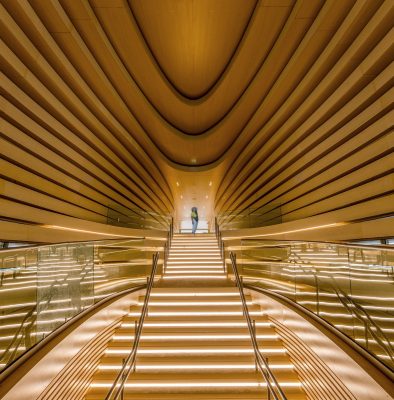
photo by Alin Constantin ; image courtesy of Es Devlin
Expo 2020 Dubai UK Pavilion Building
Dubai Expo Swedish Pavilion Building
Design: Alessandro Ripellino Architects, Studio Adrien Gardère and Luigi Pardo Architetti
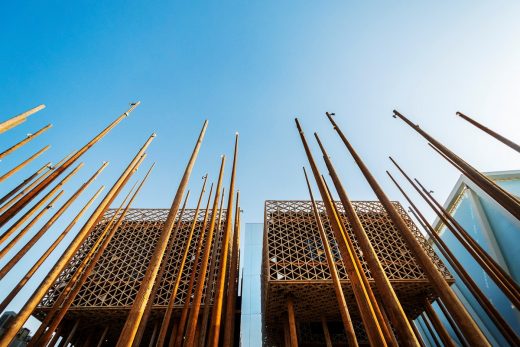
photo courtesy of Swedish government
Dubai Expo Swedish Pavilion Building
Dubai 2020 Expo Pavilions
Design: Santiago Calatrava, Foster + Partners, BIG and Grimshaw Architects
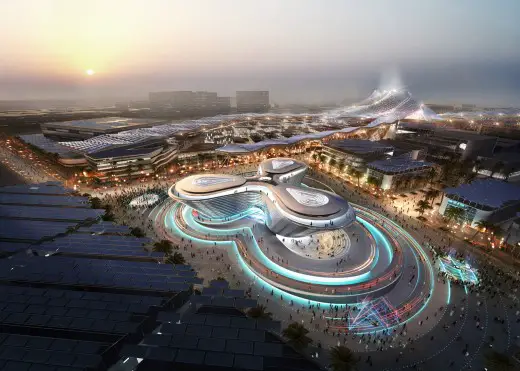
image courtesy of architects
Dubai 2020 Expo Pavilions
Design: METAFORM Architects
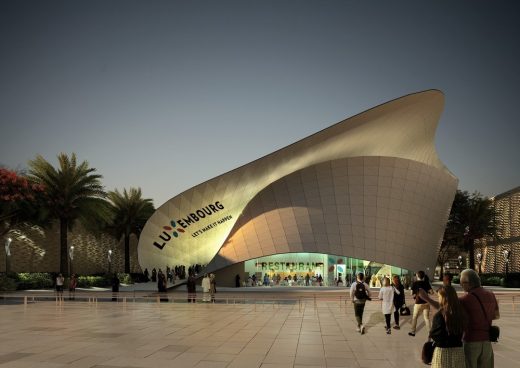
image courtesy of architects
2020 Expo Dubai Luxembourg Pavilion Building
Sustainability Pavilion for Expo 2020 Dubai
Design: Grimshaw Architects
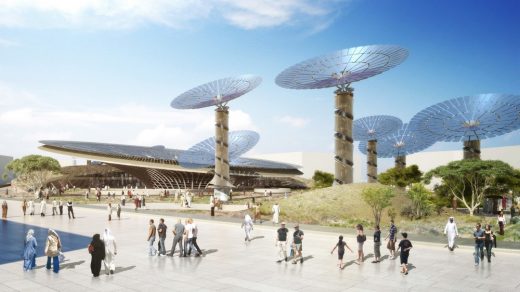
image courtesy of architects
Sustainability Pavilion for Expo 2020 Dubai
Dubai World Expo 2010 Masterplan
Design: HOK / Populous
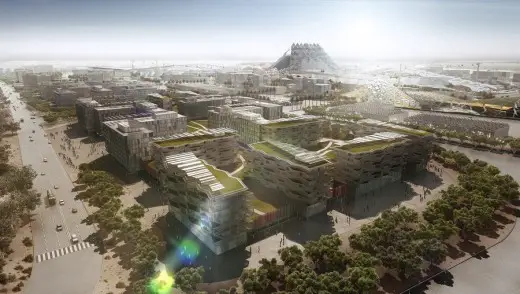
Dubai World Expo Masterplan by HOK / Populous
UAE Architecture
Hyperloop Pods and Portals
Design: BIG-Bjarke Ingels Group
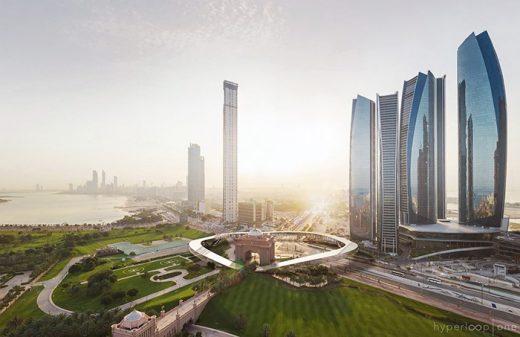
image from architects
Hyperloop Pods and Portals in Dubai
Architecture Tours Dubai by e-architect
Comments / photos for the Expo 2020 Dubai Italian Pavilion Building design by CRA-Carlo Ratti Associati and Italo Rota Building Office in UAE page welcome

